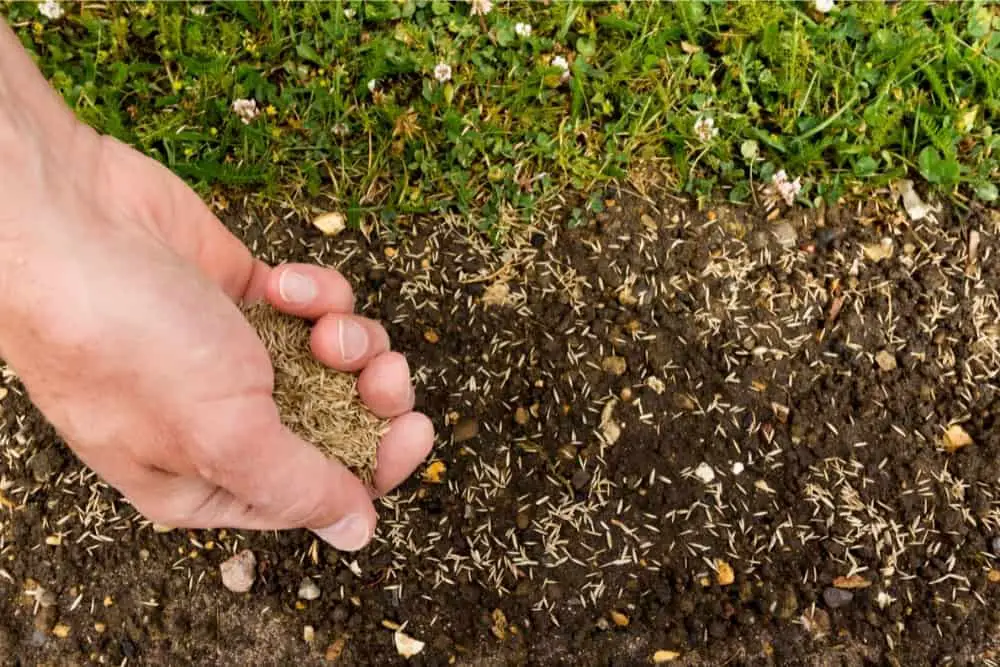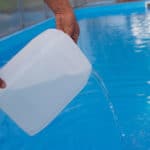From choosing a seed mixture to knowing when is the best time to sow your lawn, planting grass seed on your lawn can feel like a minefield for the inexperienced gardener.
That being said, those new to gardening might be curious to know: can you just sprinkle grass seed on the lawn?

In this article, I cover some key information about grass seed, so when it comes to planting your new lawn you’re covered!
Keep reading to find out more.
How do you plant new grass in spring?
If you are seeding new grass from scratch, there are a few things to consider and you’ll need to prep the lawn in good time before going ahead with planting your new grass seed.
Follow the steps below to ensure you get the most even lawn:
Prepare the ground - Before you start, you want a blank canvas to work with. That being said, you need to make sure that you take the time to remove any debris or weeds from the ground.
Then you’re going to want to rest the soil for 2 to 3 weeks, making sure that you get rid of any returning weeds as they appear.
Next, you can feed the soil with seed fertilizer if you wish, but this isn’t essential.
Lastly, you’ll need to divide the ground into sections. This is to ensure that when it comes to sowing, you don’t run out of grass seed!
Sow the grass seed - When it comes to sowing the grass seed, you have a few options. You can sow the seed by hand, seed drill, or use a spreader.
Generally speaking, the grass seed instructions are fairly simple to follow, so follow them as you go.
Sow the grass seed at the rate of 50grams per square meter.
Once you’ve sowed the grass seed, rake the soil lightly over the seed, then tread lightly over it to firm it in. You’ll want to bed the seed at around 5-10mm deep under the soil.
If you have a few bare patches on your lawn, then follow the following steps to overseed your lawn:
Prepare the lawn - You’ll want to begin by weeding the lawn and removing any stones that could get in the way of the new grass seed.
Next, you will need to scarify the lawn to remove any debris or moss whilst also loosening the soil.
Firm the soil by walking over it.
Lastly, two or three days before the seed is sown, you’ll want to feed the soil with fertilizer.
Sow the grass seed - To sow the grass seed, you’ll want to mow your grass to the length of approximately 25mm.
Next, you’ll want to moisten the soil, being careful to sprinkle the seed onto the lawn evenly, and be mindful to sprinkle more on the bare patches that you’re trying to fill out.
Apply the grass seeds at the rate of 35g per square meter. However, when it comes to filling the patchy areas of grass you should apply the grass seed at a rate of 50g per square meter instead to ensure that it can catch up with the rest of the lawn.
Next, lightly rake over and make sure to water your lawn after placing the new grass seed down.
Finally, make sure that you continue to monitor and mow the grass regularly.

What month is best to put grass seed down?
Generally speaking, grass seed should be sown in spring from March to May or early autumn in September to mid-October.
This is because for the grass seeds to germinate, the soil needs to be warm and damp from the rain, which is much more likely to occur in the milder seasons of spring and autumn than in the more extreme conditions that often occur in summer and winter.
However, that being said, the windows of opportunity could differ depending on where you live and how hot the climate is.
It’s important to be aware of the weather conditions before you attempt to put new grass seed down because your grass seed will need the perfect conditions in order to germinate. To avoid having your grass seed die, then, you need to pick the right moment to plant it. It isn’t as just simple as sprinkling it on the lawn and watching it grow if the conditions aren’t right.
If you find that you are too late to sow new grass seed in autumn, your next best opportunity is to try in mid-spring. However, this is only the case if you can provide the new grass seed with plenty of water.
That being said, it is important that you don’t attempt to sow grass seed in the summer. This is because it’s highly unlikely that you’ll be able to give the lawn enough water to prevent it from shriveling up and dying, and your efforts will be wasted. It’s best to bide your time.
The most important thing to remember when putting new grass seed down is that seedlings are highly susceptible to drought while they are germinating. That being said, it is important to keep them watered and to monitor them closely during dry spells throughout the spring or autumn after you sow them.
If the weather remains dry for two or three days, you will need to water the grass seeds gently with a light sprinkler until the seedlings have become established. You can monitor them by testing your soil regularly by pushing your fingers into it.
Alongside this, you will need to carefully weed the area by hand, being mindful to remove any weeds before they flower.
You will need to regularly mow and maintain your lawn. That being said, hold off until the new grass has reached mowing height. You will need to wait until your grass is dry in order to mow it and ensure that your mower blade is sharp beforehand and that you don’t cut the grass too short.









